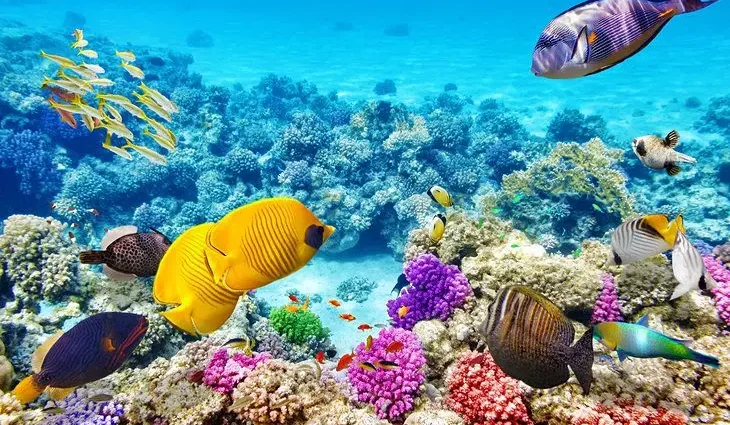Contents
- 1. Great Barrier Reef, Australia
- 2. Komodo National Park, Indonesia
- 3. Grenada, The Caribbean
- 4. Bay of Donsol, The Philippines
- 5. Baa Atoll, Maldives
- 6. Madang, Papua New Guinea
- 7. Maui, Hawaii, United States
- 8. Silver Bank, Dominican Republic
- 9. Bora Bora, French Polynesia
- 10. Isla del Cocos, Costa Rica
- 11. Los Cabos, Mexico
- 12. Isla Holbox, Mexico
- 13. Bermuda
- 14. Koh Tao, Thailand
- 15. Ambergris Caye, Belize
- 16. Sharm El Sheikh, Egypt
- 17. Devil’s Crown, Galápagos
- 18. The Solomon Islands
- Map of Places to Go Snorkeling in the World
The ocean graces more than 70 percent of our planet, and millions of marine species call these waters home. Whether you are a novice or an experienced snorkeler, there are plenty of places to witness enchanting underwater life. All you need is a mask, snorkel, and fins to experience the beauty of coral reefs and the intriguing creatures that thrive beneath the waves.
From sharing the sea with manta rays in the Maldives to humpback whales in the Dominican Republic and being surrounded by vibrant schools of fish in the Caribbean, these are the best places to go snorkeling in the world.
1. Great Barrier Reef, Australia
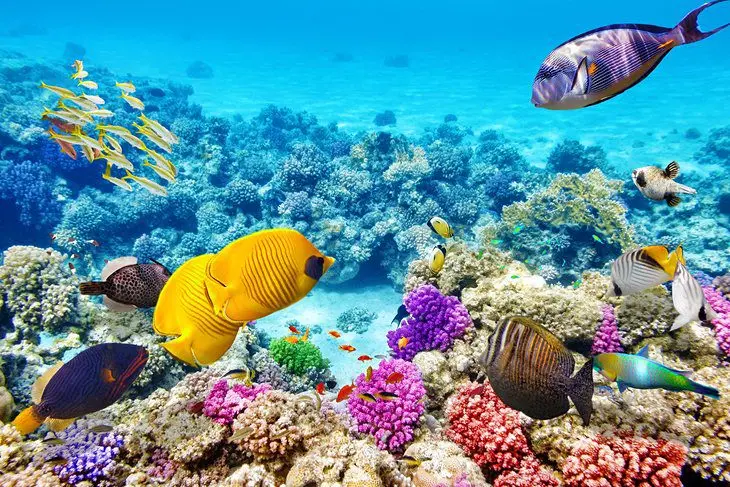
For brilliant marine life and eye-popping coral, there’s nowhere better than the Great Barrier Reef. As the planet’s largest reef system, the Great Barrier Reef is made up of 2,900 individual reefs and coral cays stretching 1,400 miles off the Queensland shoreline. More than a thousand fish species, along with six species of sea turtles, inhabit the reef.
Warming waters are causing the coral to bleach, and scientists predict that the reef could become extinct as soon as 2050. So, take in the unmatched beauty of the Great Barrier Reef before it’s too late.
The best way to experience this year-round destination is on a boat tour to various spots from your base camp in Airlie Beach, the Whitsunday Islands, Cairns, or Port Douglas.
2. Komodo National Park, Indonesia

Komodo National Park is centrally located along Indonesia’s Lesser Sunda archipelago, a chain of volcanic islands extending eastward from Java. Established in 1980 to preserve the Komodo Dragon, the Park became a UNESCO World Heritage site six years later.
As one of five islands where you can see these unique lizards in the wild, the national park gets a lot of attention, but the surrounding waters shouldn’t be overlooked. Having enjoyed protected status for more than 30 years, the reefs are thriving with an abundance of exotic undersea life, including dugongs, manta rays, sharks, and over 1000 species of tropical fish.
3. Grenada, The Caribbean
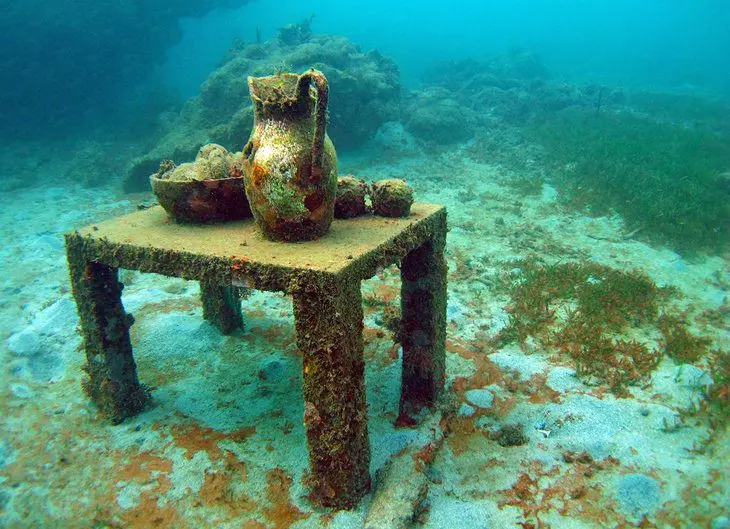
The Caribbean island famous for its spices, lush mountains, and scenic cliffs is also home to the first-ever marine sculpture garden at Molinere Sculpture Park.
Just a half-hour boat ride from Pink Gin Beach in Grenada lies a collection of ecological, subaqueous contemporary art at the sandy bottom of Molinere Bay. These coral-graced cement sculptures, including the famous ring of children holding hands, are teeming with colorful fish and offer a one-of-a-kind underwater experience.
Accommodation: Best Resorts in Grenada
- Read More: Top-Rated Tourist Attractions in Grenada
4. Bay of Donsol, The Philippines
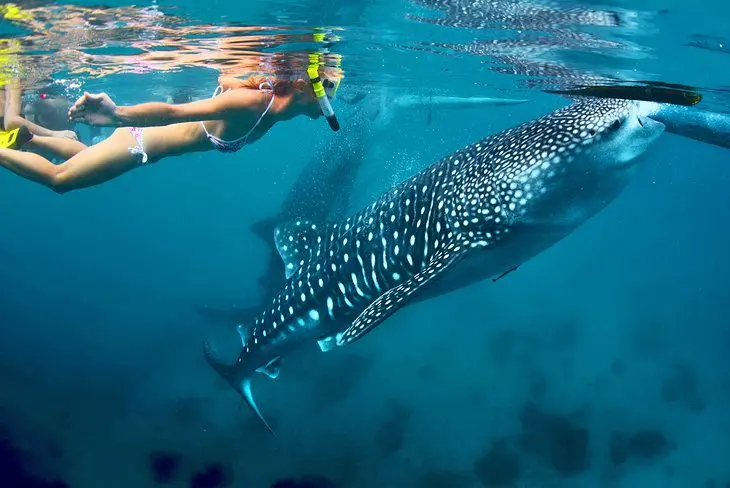
With more than 7,000 islands, choosing the right snorkeling spot is not an easy task in the Philippines. This is especially true when the waters surrounding the archipelago have a diverse ecosystem filled with breathtaking wildlife. At the Bay of Donsol, located in the Sorsogon province in the northern Philippines, you can snorkel alongside the largest living fish: the whale shark.
These protected animals congregate in Donsol Bay between November and June, feeding on the rich nutrients coming from the mouth of the river. Snorkelers can see up to 20 whale sharks on a single boat tour.
Read More: Best Places to Visit in the Philippines
5. Baa Atoll, Maldives
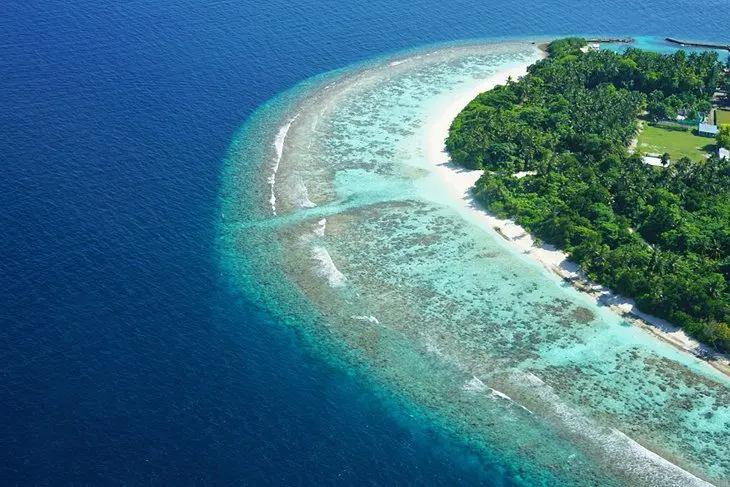
The Maldives, located southwest of India, are some of the most picturesque islands in the world, and their beauty is not just relegated to the land. The 1,200 picture-perfect coral islands are surrounded by aquamarine waters, home to hundreds of vivid fish species and other marine animals, including sharks, octopi, and manta rays.
Baa Atoll, a UNESCO Biosphere Reserve, is one of the Maldives’ 26 geographical atolls. It supports one of the largest groups of coral reefs in the Indian Ocean, and hundreds of manta rays gather to take advantage of the zooplankton trapped in the bays from June to November.
Accommodation: Best Resorts in the Maldives
6. Madang, Papua New Guinea
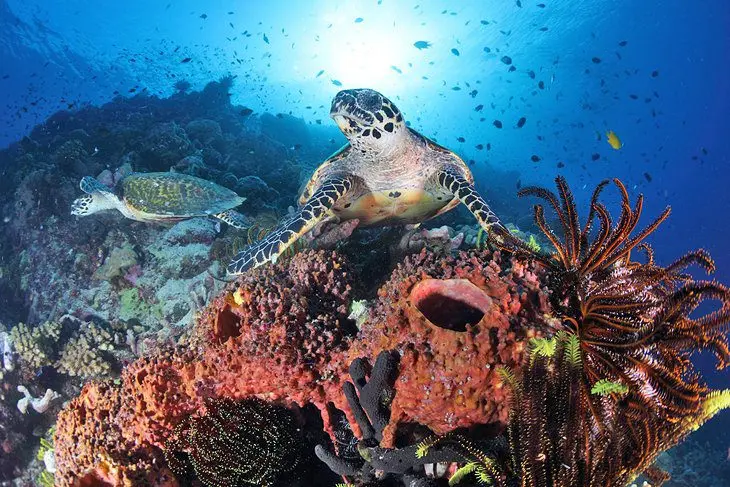
The tropical nation of Papua New Guinea is located north of Australia in the Coral Triangle, also known as the Amazon of the ocean. Papua New Guinea and its offshore islands evoke a sense of wonder, just by the very nature of their remote location. The nation boasts more than 700 tribes and it’s equally diverse beneath the seas. Because Papua New Guinea doesn’t suffer from over tourism, the reefs have remained pristine and plentiful.
Just offshore from Madang is the volcanic seamount Planet Rock, whirling with barracuda, tuna, snapper, and reef sharks. If you are into diving, there are also some WWII wrecks nearby to explore.
Accommodation: Where to Stay in Madang
7. Maui, Hawaii, United States
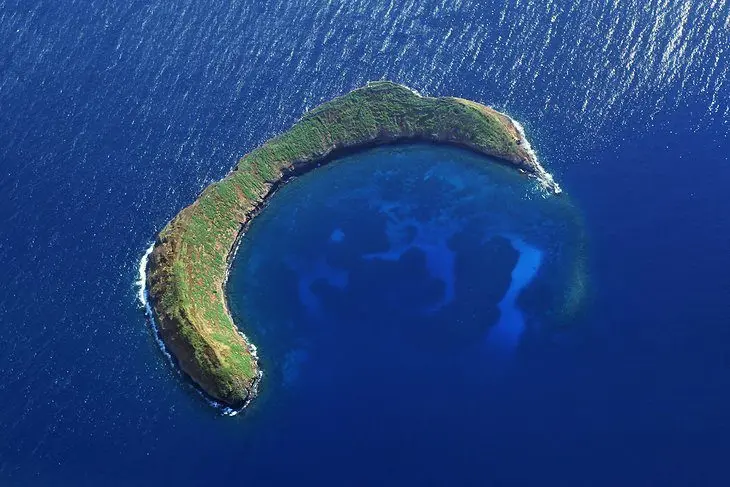
The lush island of Maui has unique lava rocks and coves that make for a one-of-a-kind experience. You can either snorkel off the island’s beaches or venture out to popular reefs to see technicolor fish, sea turtles, and coral formations.
A stone’s throw away from the Four Seasons Resort Maui is the Ahihi Kinau Natural Area Reserve, a perfect place to visit for beginners to enjoy undersea life. The Molokini Crater, a half-sunken, crescent-shaped caldera a few miles from Maui’s shores, boasts calm waters with visibility up to 100 feet. Here, you can come face-to-face with rainbow fish, eagle rays, monk seals, and sea turtles inside the arms of the crater.
- Read More: Top-Rated Tourist Attractions & Things to Do in Maui
8. Silver Bank, Dominican Republic

If you’ve ever dreamed of snorkeling alongside humpback whales, Silver Bank, in the Caribbean Sea, 80 miles north of the Dominican Republic, is the place to be. Go between December and April, when these charismatic megafauna migrate to the warm, shallow waters of Silver Bank’s submerged limestone plateau to mate, calve, and raise their young.
This Marine Mammal Sanctuary is one of only three places in the world that allows visitors to swim and snorkel among the North Atlantic humpback whales. As this is a sanctuary, only special organized tours are allowed to take snorkelers out to the water.
Accommodation: Best All-Inclusive Resorts in the Dominican Republic
Read More: Top Attractions and Things to do in the Dominican Republic
9. Bora Bora, French Polynesia
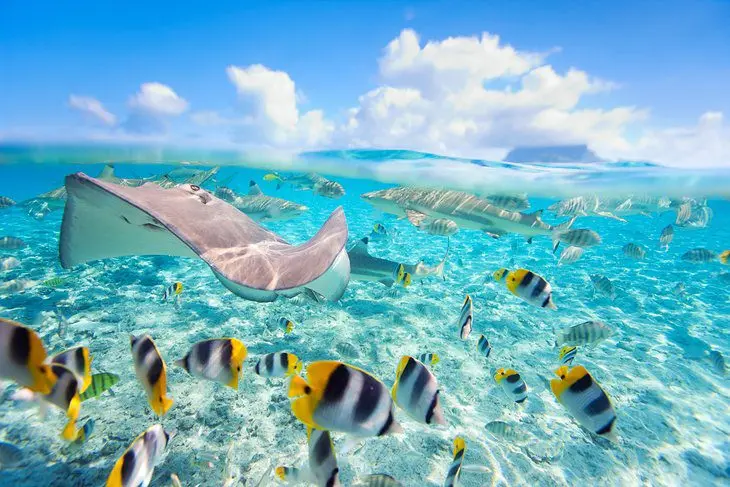
Crystal-clear waters, pure-white sand beaches, and plenty of opportunities to get up close to stingrays right from your overwater bungalows await in Bora Bora. These “water puppies,” as they are often called, inhabit the warm waters surrounding Bora Bora and neighboring islands. They have an affinity for humans, often coming right up to you for attention. Be careful not to swim directly over them or step on their long tails.
And if you’ve ever wanted to get close to sharks, these sunlit, shallow tropical waters are abundant with blacktip reef and lemon sharks, along with an array of turtles and colorful reef fish.
Accommodation: Best Resorts in Bora Bora
10. Isla del Cocos, Costa Rica
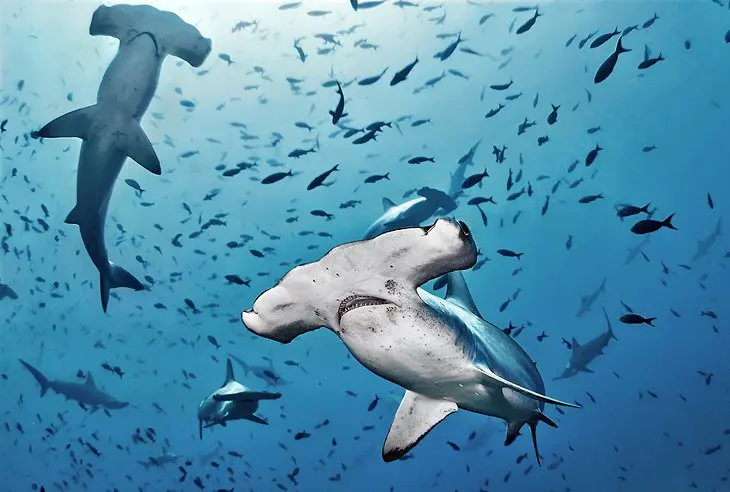
Cocos Island National Park, 340 miles off the Pacific coast of Costa Rica, is a UNESCO World Heritage site and the only island in the eastern Pacific with a tropical rainforest. Situated atop an ancient volcanic mountain, it is nicknamed “Treasure Island” as the former hideout for pirates hundreds of years ago, and today, it’s renowned for its natural treasures.
The island’s emerald waters host amazing marine life that thrives among the extinct volcano’s tunnels, caves, and coral reefs. Cocos Island is considered one of the best places to snorkel and dive with pelagic species like manta rays, moray eels, bottlenose dolphins, the occasional whale shark, and schools of hammerhead sharks.
Accommodation: Top-Rated Beach Resorts in Costa Rica
Read More: Top Attractions & Places to Visit in Costa Rica
11. Los Cabos, Mexico

Los Cabos, situated at the southern tip of Mexico’s Baja Peninsula, is nestled between the coastlines of the Pacific Ocean and the Sea of Cortez. On the East Cape is Cabo Pulmo, a protected National Marine Park recognized as a UNESCO World Heritage Site, home to one of the three coral reefs in North America.
While the coral reef here isn’t the deep red color you’d find in Southeast Asia destinations, Cabo Pulmo’s living reef is estimated to be 20,000 years old, with 800 species of marine life — making this “Aquarium of the World” a perfect destination for snorkeling to see parrot fish, angelfish, damselfish, dolphins, sharks, and whales.
Accommodation: Best All-inclusive Resorts in Los Cabos
- Read More: Top-Rated Things to Do in Cabo San Lucas, Mexico
12. Isla Holbox, Mexico
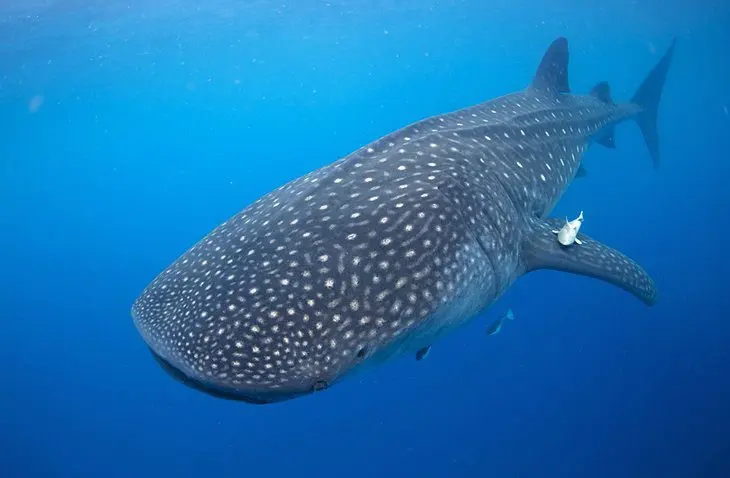
Cancun and Tulum get all the attention, but it’s this sleepy island off Mexico’s Yucatan Peninsula in the Gulf of Mexico that’s now garnering buzz as a top ecotourism destination for swimming with whale sharks. During the summer months, these gentle giants swim near the surface feeding on plankton.
You may also witness sea turtles, manta rays, and dolphins. This car-free island is one of the Yucatan’s lesser-known destinations, which equals fewer tourists to rub elbows with on your snorkeling adventure.
13. Bermuda

Throughout history, many ships have wrecked along the shores of Bermuda. Nicknamed by sailors as Devil’s Island, this tiny British Overseas island in the middle of the Atlantic offers wreck enthusiasts a chance to get up close to these underwater marine and coral reef havens. There are estimated to be around 300 shipwrecks in the surrounding waters.
While Church Bay and Tobacco Bay are best for snorkeling in tranquil waters right from the beach, those looking for shipwrecks need to book a boat to head a few miles offshore. At Western Blue Cut on the northwest, two shipwrecks — 19th-century Constellation and Montana — sit in less than 20 feet of water. The HMS Vixen, a three-masted British gunboat from 1867, can be seen semi-submerged off the West End.
Water is usually 28 degrees Celsius during the summer, and visibility remains clear up to 80 feet, allowing for prime viewing of colorful tropical fish. Adventure seekers can continue to go snorkeling in wet suits during January through March.
Accommodation: Best Resorts in Bermuda
Read More: Top-Rated Tourist Attractions in Bermuda
14. Koh Tao, Thailand
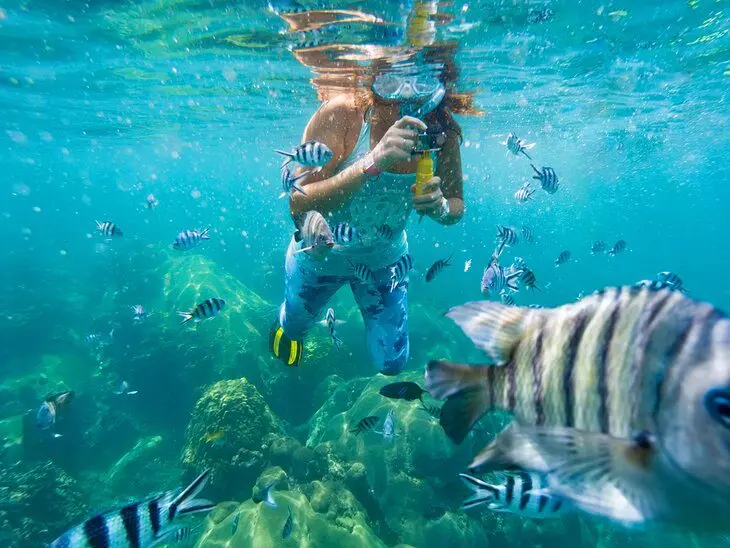
Located on the Gulf of Thailand, Koh Tao has been a scuba diving and snorkeling mecca for decades. Perfect blue waters, incredible marine life, and easily accessible bays cater to both beginners and experts.
The protected Tanote Bayon in Eastern Koh Tao offers over 20 kilometers of gently sloping coastline with a very rich coral reef life that includes everything from angelfish to bluespotted ribbontail rays. Since the coral starts just steps from the beach, it’s the perfect destination for beginners and those who want to go snorkeling on their own.
Accessible only via boat, Haad Tien Beach in the south of the island is the only place in the area where you can snorkel with both green turtles and sharks — though these are black-tip reef sharks, so you don’t have to worry about safety. Nearby Sai Daeng beach, which can only be reached with a kayak, offers well-preserved coral.
Also on the southern coast, there’s Aow Leuk Bay, famous for its amazing tropical fish, which include the colorful saddleback clownfish and the very large Jenkins stingrays.
As the most popular destination in Koh Tao, Mango Bay can get a little crowded, but since the reef area is so big, once you get into the water, you’ll have plenty of space to swim among the sea life.
Dive operators in nearby Koh Samui offer excursions to Koh Tao.
15. Ambergris Caye, Belize
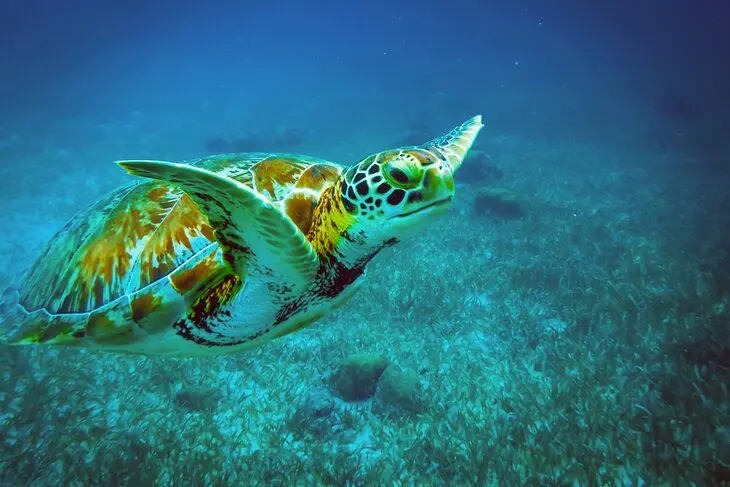
The massive Belize Barrier Reef is one of the best snorkeling destinations in Central America. Although visibility and the quality of marine life are great year-round, November to May are prime snorkeling months because they’re part of the dry season, so you don’t have to worry about storms hitting the coast and stirring the waters or affecting boat trips.
Though there are plenty of snorkeling destinations in this small country, the island of Ambergris Caye and the surrounding Hol Chan Marine Reserve are prime places to visit for many reasons. Snorkeling at Hol Chan Marine Reserve is one of the top things to do in Belize.
In addition to stunning clear blue waters, soft white sands on the bottom, and easy access from San Pedro, the reserve is also home to Shark Ray Alley, where you’ll have a chance to snorkel around nurse sharks and stingrays.
From the island, you can also take boat rides to snorkel at Tres Cocos (a shallow area with lots of colorful fish); beginner-friendly Mexico Rocks; and Mata Cut, which features a great shipwreck covered in coral and thousands of tiny fish.
Read More: Top-Rated Things to Do in San Pedro, Belize
16. Sharm El Sheikh, Egypt
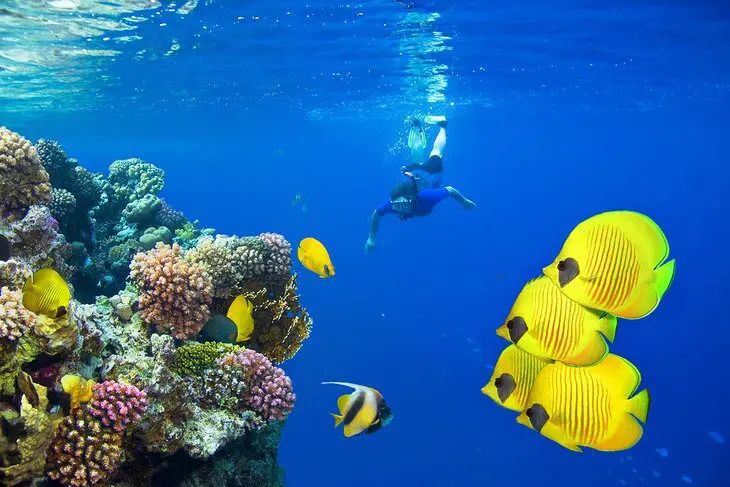
Egypt’s most famous snorkeling destination is at the top of the list there for a reason. This beautiful and well-developed resort area faces the Red Sea and offers plenty of beautiful resorts, private beaches, and boats to take you to the best coral areas.
Some of the most stunning snorkeling destinations, however, are located in southern Sharm el-Sheikh, where you’ll find the postcard-perfect Faraana Reef, with its turquoise waters, giant clams, and large schools of zebra surgeons, and red coachfish.
There’s also Ras Um Sid and its stunning coral wall and Ras Katy, with large coral pinnacles and larger fish, including the beautiful Sohal surgeonfish.
The best part about this top-notch destination for underwater lovers is that there’s coral just off the beach in many places, perfect for beginners. For advanced snorkelers and divers, there are even better spots just a short boat trip away.
Either way, you’ll find perfect visibility (thanks to the clear waters and the bright sunlight penetrating deep into the sea) and amazing underwater life that includes everything from parrotfish and anthias to Napoleon wrasse, turtles, and mantas.
Some of the islands are rich in mangroves, providing a diverse environment with even more species. The Ras Mohammed Marine Park is home to not only mangroves but also to anemones, whitetip and blacktip reef sharks.
Read More: Top-Rated Things to Do in Sharm el-Sheikh
17. Devil’s Crown, Galápagos
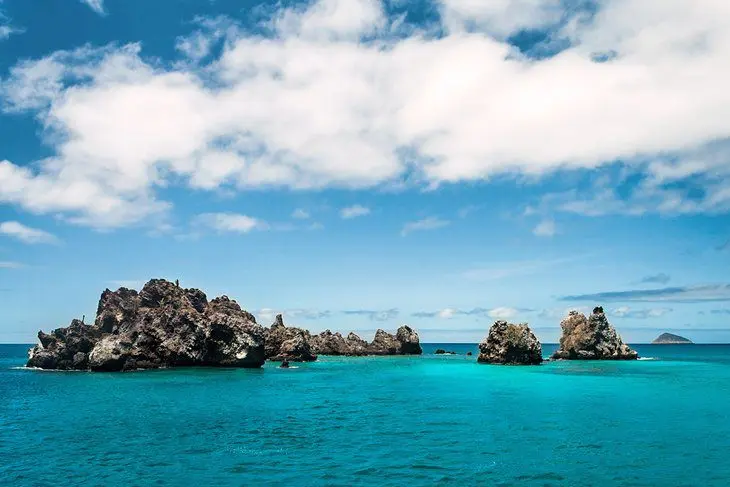
Devil’s Crown, an extinct sunken volcanic cone near Floreana Island, attracts snorkelers and divers to its underwater kaleidoscope of fish, eagle rays, and shy reef sharks. The Galápagos Islands are located 600 miles west of Ecuador in the Pacific Ocean. The area’s nickname was derived from the circular formation of jagged lava rocks.
Within a few minutes of snorkeling at Devil’s Crown, you will spot a myriad of sea life – including sea turtles and eagle rays gently “flying” above lavender and green-colored coral reefs. If you venture outside the crown, you may even see hammerhead sharks. Just beware – the currents are strong – and be sure you follow an experienced guide.
Read More: Top-Rated Tourist Attractions in Ecuador
18. The Solomon Islands

Located to the east of Papua New Guinea, this group of islands might be a bit hard to reach, but this has made them a much sought-after destination for pristine coral reefs and among the richest marine biodiversity on the planet.
Considered one of Oceania’s natural wonders, the Solomon Islands offer plenty of unique snorkeling destinations, including a famous WWII plane wreck hidden under a mangrove forest and the Blue Lagoon, a stunning destination of turquoise waters shared by blacktip reef sharks, manta rays, and lots of sea turtles.
Whether you are a beginner or a seasoned snorkeler, there are plenty of amazing options for you here. Sunset reef offers lots of beautiful coral bommies, while Uepi island offers a breathtaking experience swimming with giant manta rays.
Simon’s Nature Reserve, which requires a boat ride, is a coral paradise that receives just the perfect amount of sunlight to highlight all the bright colors of the underwater world.
Read More: Best Islands in the South Pacific










